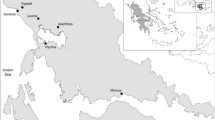Abstract
Artemia individuals from a wild population, bearing cestode cysticercoids (Hymenolepididae) were kept in the laboratory during four months to observe influences of the parasite on the host biology. No differences were found between parasitized and unparasitized shrimps regarding final adult size. The higher survival of parasitized animals suggests that parasitism is not pathogenic. The most dramatic effect was host castration. Parasitized individuals showed higher total lipid levels, probably linked to carotenoid pigments conveying a red color to parasitized shrimps.
Similar content being viewed by others
References
Amat, F., F. Hontoria, J. C. Navarro & A. Gozalbo, 1988. Bioecologia de Artemia de la laguna de La Mata (Torrevieja, Alicante). Actas Coloq. Luso-Espanhol. Ecol. Bacias Hidrog. Rec. Zool.: 17–24.
Amat, F., M. P. Illescas & J. Fernandez. Brine shrimp Artemia from Spanish Mediterranean salterns parasitized by Flamingolepis liguloides (Cestoda, Hymenolepididae) cysticercoids. (in preparation).
Baudoin, M., 1975. Host castration as a parasitic strategy. Evolution 29; 335–352.
Brown, A. F. & D. B. A. Thompson, 1986. Parasite manipulation of host behaviour: acanthocephalans and shrimps in the laboratory. J. Biol. Educ. 20: 121–127.
Calentine, R. I., 1967. Larval development of four caryophyllaeid cestodes. J. Iowa Acad. Sci. 72: 418–424.
Codreanu, R. & D. Codreanu-Balcescu, 1978. The occurrence in Artemia salina L. (Crustacea Anostraca) from Rumania of a peculiar cysticercoid larva belonging to avian hymenolepididae (Cestoda). Proc. IVth. Int. Cong. Parasit. Ser. B: 39 pp.
Courtney, C. C. & B. M. Christensen, 1987. Host-parasite relationships of caryophyllaeid cestodes and aquatic oligochaetes: I. Host longevity and parasite intensity. J. Parasitol. 73: 1124–1132.
Fischer, H., 1968. The life cycle of Proteocephalus fluviatilis Bangham (Cestoda) from smallmouth bass, Micropterus dolomieui Lacépède. Can. J. Zool. 46: 569–580.
Gabrion, C., G. MacDonald & V. Boy, 1982. Dynamique des populations larvaires du cestode Flamingolepis liguloides dans une population d'Artemia en Camargue. Acta Oecolog. 3: 273–293
Gozalbo, A. & F. Amat, 1988. Composición bioquímica de biomasas silvestres de Artemia. Investigación Pesquera 52: 375–385.
Hynes, H. B. N., 1955. The reproductive cycle of some British freshwater Gammaridae. J. anim. Ecol. 24: 352–387.
Hurd, H. & C. Arma, 1987. Hymenolepis diminuta: Effect of infection upon the patency of the follicular epithelium in the intermediate host, Tenebrio molitor. J. Int. Pathol. 49: 227–234.
Hurd, H., J. C. Mercer & A. E. Munn, 1987. The effect of Hymenolepis diminuta upon ecdysteroid activity in the haemolymph of the intermediate host, Tenebrio molitor. Parasit. Res. 74: 198–199.
Jarecka, L., 1984. Development of Hymenolepis arctowskii Jarecka et Ostas, 1984 (Cestoda, Hymenolepididae) in the intermediate host Branchinecta gaini Daday (Branchiopoda) of the Antarctic. Acta Parasit. Pol. 29: 337–342.
Kennedy, C. R., 1972. The effect of the cestode Caryophyllaeus laticeps upon production and respiration of its intermediate host. Parasitology 59: 783–794.
Keymer, A. E., 1980. The influence of Hymenolepis diminuta on the survival and fecundity of the intermediate host, Tribolium confusum. Parasitology 81: 405–421.
Macma, M., 1986. Experimental infection of Tribolium confusum (Coleoptera) by Hymenolepis diminuta (Cestoda): host fecundity during infection. Parasitology 92: 405–412.
Maksimova, A. P., 1973. Branchiopoda as the intermediate hosts of Hymenolepididae. Mat. Int. Con. Hymenolep. W. 14–16: 82–85.
Maksimova, A. P., 1974. Branchiopods (Branchiopoda, Anostraca), intermediate hosts of cestodes Fam. Hymenolepididae. Parazitologiya 7: 349–352.
Maksimova, A. P., 1976. A new cestode, Fimbriarioides tadornae sp. N. from Tadorna tadorna and its development in the intermediate host. Parazitologiya 10: 16–24.
Moore, J., 1983. Parásitos que cambian el comportamiento de su patrón. Investigación y Ciencia 94: 58–65.
Moore, J., 1984. Altered behavioral responses in intermediate hosts. An acanthocephalan parasite strategy. Am. Nat. 123: 572–577.
Mueller, J. F., 1963. Parasite induced weight gain in mice. In T. C. Chang (Ed.) Some biochemical and immunological aspects of host-parasite relationships. Ann. N. Y. Acad. Sci. 113: 217–233.
Munro, W. R., 1953. Intersexuality in Asellus aquaticus L. parasitized by a larval acanthocephalan. Nature 172: 313.
Muzzall, P. M. & F. C. Rabalais, 1975a. Studies on Acanthocephalus jacksoni Bullock. 1962. II An analysis of the host-parasite relationship of larval Acanthocephalus jacksoni in Lirceus lineatus (Say). Proc. Helm. Soc. Wash. 42: 35–38
Pearre, S., 1976. Gigantism and partial parasitic castration of chaetognata infected larval trematodes. J. mar. biol. Ass. U.K. 56: 503–513.
Schmidt, G. D., 1964. Life cycle and development of Prosthorhynchus formosus (Van Cleave, 1918) Travassos, 1926. an acanthocephalan parasite of birds. Dissertation. Colorado St. Univ. Disserts. Fort Collins. Col. USA.
Sokal, R. R. & F. J. Rohlf, 1981. Biometry. W. H. Freeman & Co. New York, 859 pp.
Stark, G. T. C., 1965. Diplocotyle (Eucestoda), a parasite of Gammarus zaddachi in the estuary of the Yorkshire Esk. Britain. Parasitology 55: 415–420.
Author information
Authors and Affiliations
Rights and permissions
About this article
Cite this article
Amat, F., Gozalbo, A., Navarro, J.C. et al. Some aspects of Artemia biology affected by cestode parasitism. Hydrobiologia 212, 39–44 (1991). https://doi.org/10.1007/BF00025985
Issue Date:
DOI: https://doi.org/10.1007/BF00025985




